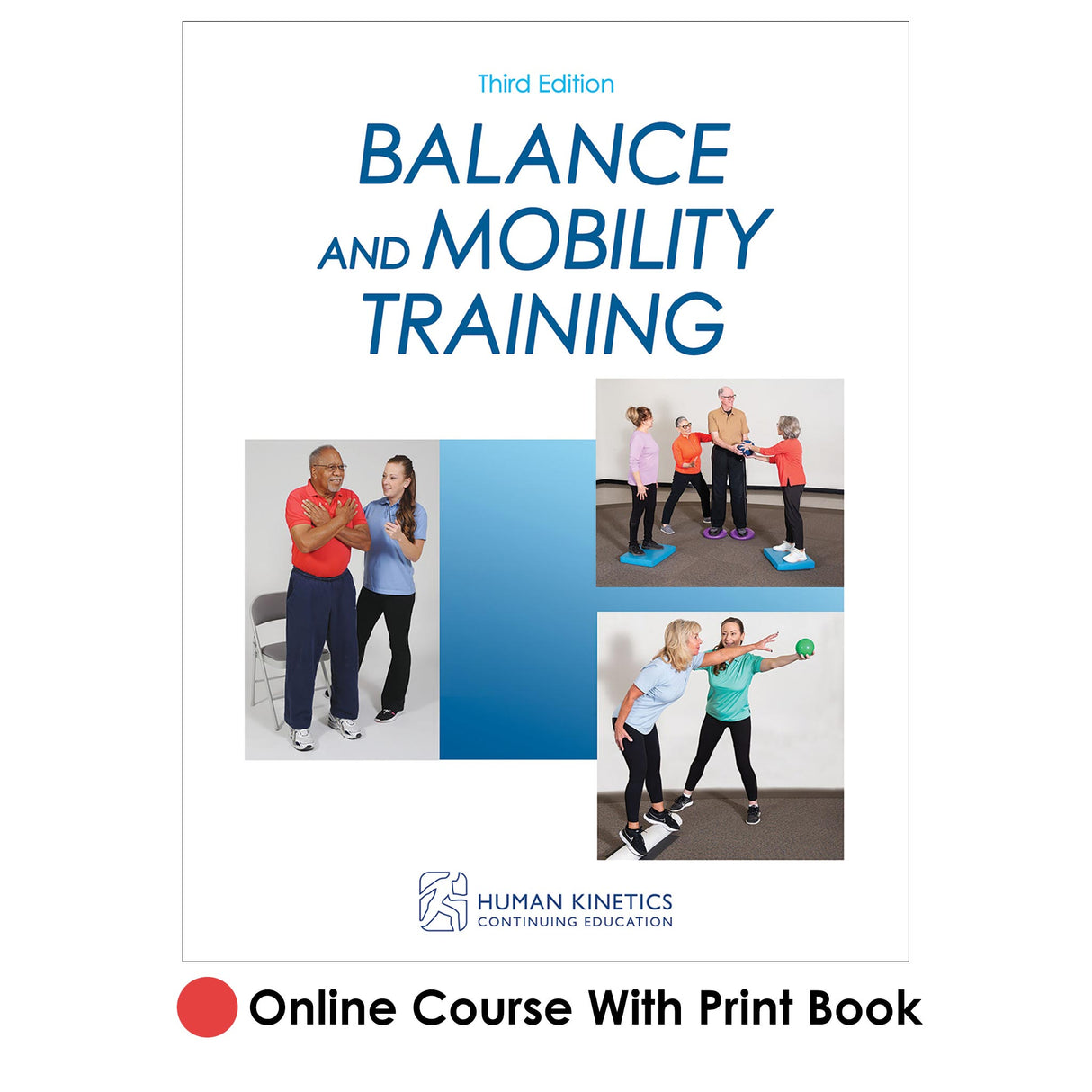Balance and Mobility Training 3rd Edition Online CE Course With Print Book
Author: Human Kinetics
$178.95 CAD
Human Kinetics strongly recommends that you complete your exam within the calendar year of your date of purchase to ensure approved credits do not expire for your organization.
- FallProof! A Comprehensive Balance and Mobility Training Program, Third Edition With HKPropel Access, book
- Online access to downloadable forms through HKPropel (code provided in book)
- Online video clips
- Online continuing education exam
This course is based on the book FallProof! A Comprehensive Balance and Mobility Training Program, written by the foremost experts in balance disorders, Debra Rose and Elizabeth White, and thoroughly updated with the latest research and guidelines for the popular FallProof! program. This third edition features key updates to tests, programming, and revised assessments, including the Expanded Fullerton Advanced Balance (E-FAB) scale and the Walking While Talking Test.
Indispensable for health professionals working with the older adult population, the book includes case studies, expert insights, and practical analysis to prepare practitioners to anticipate, understand, and manage the age-related changes their clients experience. Professionals can help clients address the functional limitations that often result in falls with a variety of balance, strength, endurance, and flexibility exercises:
- 17 upper-body exercises, 4 of which are new
- 4 new abdominal exercises
- 18 lower-body and foot and toe exercises
- 5 new compound floor exercises
- 30 flexibility exercises and stretches, 7 of which are new
You’ll also receive online access to 12 reproducible forms, questionnaires, score sheets, and a sample lesson plan. Seven videos demonstrate screening tests to help assess clients and monitor their progress. This course delivers the specialized knowledge and practical skills required for creating programs that ensure older adults develop and maintain the balance and mobility essential in avoiding falls and aging successfully.
Once you complete the course and pass the exam, you can print a certificate for continuing education credits.
Learning Objectives
- Explain the fundamentals of the systems framework of postural control (SFPC) program.
- Identify common age-related body systems changes that are strongly associated with falls.
- Use FallProof assessment criteria to evaluate students before and during FallProof program implementation programming.
- Design progressive balance and mobility programs using the six major components of the FallProof program.
- Apply appropriate modifications for participants with motor and neurological limitations.
- Prepare FallProof programming challenges that simulate everyday living environments.
- Provide appropriately progressive exercise challenges for each balance activity.
- Enhance FallProof programming with supplemental flexibility exercises.
- Create an engaging and supportive motor learning environment.
- Develop leadership skills that engage and inspire students.
Audience
Certified professionals working with older adult populations in retirement communities, physical activity programs, rehabilitation and therapy programs, and long-term care facilities.Chapter 1. Understanding Balance and Mobility
What Is Balance?
Terminology
Postural Control Strategies for Controlling Balance
Systems Contributing to Balance and Mobility
Age-Associated Changes in the Systems Contributing to Balance and Mobility
Case Studies
Summary
Test Your Understanding
Practical Problems
Chapter 2. Why Do Many Older Adults Fall?
Multiple Factors Cause Falls
Effects of Common Medical Conditions
Effect of Medications on Balance and Mobility
Fear of Falling
Are the Risks the Same for All Older Adults?
Practical Implications for Program Planning
Summary
Test Your Understanding
Practical Problems
Part II. The FallProof Program for Improving Balance and Mobility
Chapter 3. Screening and Assessment
Systems Framework of Postural Control
Health and Physical Activity Patterns
Assessing Functional Ability
Assessing Fall Risk
Assessing the Multiple Dimensions of Balance and Gait
Summary
Test Your Understanding
Practical Problems
Chapter 4. Center-of-Gravity Control Training
Seated Balance Activities
Standing Balance Activities
Floor-to-Standing Transfers
Summary
Test Your Understanding
Practical Problems
Chapter 5. Multisensory Training
Forcing the Use of the Somatosensory System to Control Balance
Forcing the Use of the Visual System to Control Balance
Forcing the Use of the Vestibular System to Control Balance
Exercises Coordinating Eye and Head Movements
Summary
Test Your Understanding
Practical Problems
Chapter 6. Postural Strategy Training
Practice Requirements
Progressive Exercise Activities
Summary
Test Your Understanding
Practical Problems
Chapter 7. Gait Pattern Enhancement and Variation Training
Overview of the Gait Cycle
Mechanisms Controlling Gait
Age-Associated Changes in Gait
Effect of Pathology on the Gait Pattern
Gait Pattern Enhancement and Variation Training
Culminating Activities
Summary
Test Your Understanding
Practical Problems
Chapter 8. Strength and Endurance Training
Selected Upper-Body Strength Exercises
Selected Abdominal Strength Exercises
Selected Lower-Body Strength Exercises
Selected Compound Floor Exercises
Selected Exercises for the Foot and Toes
Summary
Test Your Understanding
Practical Problems
Chapter 9. Flexibility Training
Selected Neck and Upper-Body Flexibility Exercises
Selected Lower-Body Flexibility Exercises
Selected Floor-Based Flexibility Exercises
Summary
Test Your Understanding
Practical Problems
Part III. Implementing the FallProof Program
Chapter 10. Setting the Stage for Learning
Understanding the Stages of Learning
Understanding Different Learning Styles
Introducing the Skill Being Learned
Identifying and Correcting Errors in Performance
Summary
Test Your Understanding
Practical Problems
Chapter 11. Program Planning and Class Management Techniques
Following the Initial Assessment
Setting Individual Program Goals
Before Each Class Session
During Each Class Session
Between Class Sessions
After Each Follow-Up Assessment
Communicating With Class Participants
Summary
Test Your Understanding
Practical Problems
Appendix A. Balance Kit Inventory
Appendix B. Answer Key for Test Your Understanding Questions





